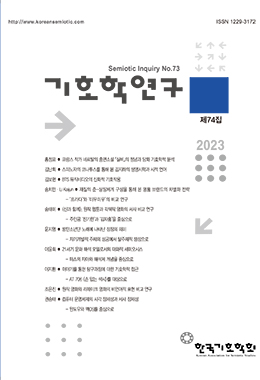브랜드 정체성의 확보에서 상품이 갖는 위상은 본원적이라 할 수 있다. 상품 판매라는 궁극적인 목적뿐만 아니라 상품이 브랜드 차별성을 구성하는 데 중요한 역할을 하기 때문이다. 상품을 구성하는 구상적 문양뿐만 아니라 색상, 재질, 형태 등은 다양한 의미 생산에 참여할 수 있다. 본 연구는 상품을 구성하는 가죽 재질이라는 조형적 요소가 의미작용에 참여할 뿐만 아니라 브랜드 차별화에 이르는 과정을 살펴보고자 한다. 조형 기호학의 이론을 통해 상품 재질의 물리적 특성을 넘어서는 고유한 의미를 파악할 수 있다. 이를 위해 플로슈가 제안하는 조형 기호학의 핵심이론이라 할 수 있는 준-상징체계를 활용해 표현의 대립 범주를 도출하고 이에 상응하는 의미 요소를 확정하는 방식을 채택한다. 고립된 텍스트 안에서 작동하는 준-상징체계의 특성을 고려해서 의미 요소의 도출은 로고 분석의 결과에 의지하고자 한다. 로고는 브랜드의 가치나 의미를 응축하고 있는 기호 단위이기 때문에 의미 요소 도출에 결정적 역할을 할 수 있다.
본 연구는 ‘프라다’(Prada)와 ‘미우미우’(MiuMiu) 두 브랜드를 분석대상으로 선택한다. 두 브랜드는 같은 그룹에 속하지만 서로 다른 정체성을 바탕으로 다른 마케팅 전략을 수행한다. 먼저 두 브랜드의 로고를 분석하고, 두 브랜드가 대표적으로 사용하는 가죽 소재라고 할 수 있는 ‘사피아노’와 ‘마테라쎄’의 준-상징체계를 구성해서 차별화의 과정을 설명한다. 두 가죽 재질의 조형적 불변소들이 체계적으로 상반된 관계를 유지하고 있다는 것을 확인하고 로고 분석의 결과를 활용해 이에 상응하는 의미 범주를 도출해 준-상징체계를 완성한다. 표현적 측면에서 /직선/ 대 /곡선/, /딱딱한/ 대 /유연한/, /거친/ 대 /부드러운/, /연속적/ 대 /불연속적/과 같은 범주적 대립이 두드러진다. 의미적 측면에서, ‘프라다’가 왕실의 공식 공급업체이자 귀족을 주 소비층으로 하고 있으며, 설립자 마리오 프라다가 ‘고급스러움’을 명시적으로 선언하고 있다는 점에서 /전통적/, /성숙함/이라는 의미를 도출할 수 있다. 반면에 ‘미우미우’는 전략적으로 프라다와 차별화되는 의미를 지향하고 있다. 기존의 가치를 답습하지 않는 여성상을 수립한다는 점에서 /혁신적/ 가치를 도출할 수 있고 미우치아 프라다의 소녀스러운 모습을 담고자 했다는 브랜드 스토리에서 /젊음/이라는 의소도 도출할 수 있다. 결국 /전통/ 대 /혁신/, /성숙함/ 대 /젊음/이라는 의미 대립 범주를 도출하면서 두 재질의 준-상징체계가 구성된다.
마지막으로 재질의 표현과 내용의 교차 변화를 통해 두 브랜드가 차별화되는 과정을 볼 수 있으며, 이를 통해 두 브랜드가 어떻게 차별화 전략을 수행하는지 확인할 수 있다. ‘사피아노’, ‘리나일론’, ‘마테라쎄’ 가죽 사이에 존재하는 점진적 변화가 두 브랜드의 차이를 보장하고 있다는 것이다. 이 연구를 통해 ‘프라다’와 ‘미우미우’가 가방의 재질을 통해 브랜드 차별화와 혁신에 이르는 과정을 살펴볼 수 있다. 상품을 구성하는 재질만으로도 브랜드의 정체성 확보와 차별화가 가능하다는 점을 확인하고 기호학적 절차를 통해 그 과정을 제시했다는 데서 연구의 가치를 찾을 수 있다.
In ensuring brand identity, the status of a commodity plays a fundamental role as it not only represents the ultimate goal of product sales but also plays a crucial part in constituting brand distinctiveness. Beyond tangible features like figuratif patterns, colors, materials, and forms, various meanings can be conveyed in the production of commodities. This study aims to explore the significance of leather materials, as a constituting element of commodities, and observe the process of brand differentiation. Drawing upon the theory of plastic semiotics, inherent meanings that transcend the physical properties of the materials can be grasped. To achieve this, Jean-Marie Floch’s core theory of plastic semiotics’ semi-symbolic system is adopted to derive the polarized categories of representation and identify corresponding meaningful elements. Given the characteristics of the semi-symbolic system operating in isolated texts, the extraction of meaningful elements relies on the results of logo analysis. As signs condensing brand value or meaning, logos play a decisive role in extracting meaningful categories.
Two brands, “Prada” and “MiuMiu” are selected as subjects of analysis. Although both belong to the same group, they implement different marketing strategies based on different identities. First, the logos of the two brands are analyzed, and through the semi-symbolic system of representative leather materials, “Saffiano” and “Matelasse,” their differentiation process is explicated. By confirming that the morphological invariants of the two leather materials maintain an opposing relationship, we derive the corresponding categories of meaning using the results of sign analysis, thereby constructing the semi-symbolic system. At the expressive level, the polarized categories are highlighted, such as /straigh/ lines versus /curves/, /hardness/ versus /softness/, /roughness/ versus /gentleness/, and /continuity/ versus /discontinuity/. In terms of contents, “Prada” serves as the official supplier to the royal family with the main consumer group being nobility, and its high-end image conveys /traditional/ and /mature/ meanings. In contrast, “MiuMiu” is strategically pursuing a meaning different from Prada. Based on the establishment of a female image that does not follow the existing values, /innovative/ values can be derived, and the appeal of /youth/ can be derived from the brand story that tried to contain Miuccia Prada’s girlish image. Ultimately, the semi-symbolic system of the two materials is formed through the identified categories of meaning, reflecting the contrast between /tradition/ and /innovation/ and between /maturity/ and /youthfulness/.
Finally, through the interactional changes in material expression and content, we observe the process of differentiation for the two brands. This allows us to confirm how both brands execute differentiation strategies. In other words, the gradual changes between the “Saffiano”, “Nylon,” and “Matelasse” ensure their differentiation. Through this study, we gain insight into how “Prada” and “MiuMiu” achieve brand differentiation and innovation through the materials of their bags. The mere material composition of commodities can guarantee overall brand integrity and differentiation. This process is proposed through semiotic steps, and the research holds promising significance.




